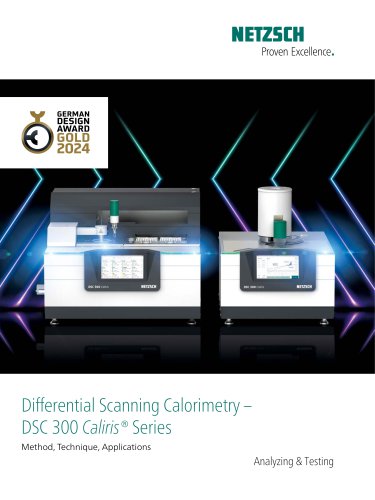 Website:
NETZSCH Analyzing & Testing
Website:
NETZSCH Analyzing & Testing
Group: NETZSCH
Catalog excerpts

Instruments for Testing Refractories Hot Modulus of Rupture - HMOR 422 Refractories under Load and Creep in Compression - RUL/CIC 421
Open the catalog to page 1
Today, selection of the proper refractory material is more crucial than ever when it comes to improving the cost-effectiveness of a process and prolonging the life cycle. Appropriate selection of the refractory furnace lining can only be made with accurate knowledge of the properties of the refractory materials and the stresses on the materials during service. Thermomechanical properties are determined using high-temperature test methods with external forces causing stresses on the tested material. The stress-strain behavior of refractories at high temperatures includes reversible elastic...
Open the catalog to page 2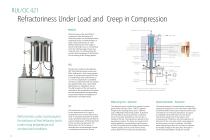
NETZSCH Instruments for Testing Refractories under Thermal and Thermomechanical StressThermal and Thermomechanical Properties Instrument Temperature Range Refractoriness under Load (RUL) Refractoriness under Load/ Creep in Compression (CIC) Creep in Compression (RUL/CIC 421) Hot Modulus of Rupture (HMOR 422) RT to 1500°C Thermal Expansion (DIL) Dilatometer Volume Stability (DIL) (DIL 402 E, DIL Expedis series) Thermal Stress Specific Heat Capacity (LFA) Specific Heat Capacity (DSC) Thermal Diffusivity/ Thermal Conductivity (LFA) Instrument Temperature Range Laser/Light Flash Apparatus (LFA...
Open the catalog to page 3
Refractoriness under load evaluates the behavior of fired refractory bricks under rising temperature and constant load conditions. Method Refractoriness under load (RUL) is a measure of the resistance of a refractory product to subsidence when subjected to the combined effects of load, rising temperature at a predefined heating rate. The range in which softening occurs is not identical with the melting range of pure raw materials, but it is influenced by the content and the degree of distribution of low melting point fluxing agents. RUL The RUL test method is described in ISO 1893,...
Open the catalog to page 4
Creep in Compression Variable load Loading column Heating element Sample Protective tube Inner thermocouple Outer thermocouple Control thermocouple Outer tube Inner tube Hood type furnace Supporting column Sample with coaxial bore and inner tube Bellows Vacuum-tight seal Variable contact force Gastight casing Evacuating system Inductive transducer Gas inlet Schematic of the gas-tight RUL/CIC 421 G/6 for measurements in protective gas atmosphere Measuring Unit – Specimen Signal Generation – Expansion The measuring unit consists of a console, furnace guide frame, furnace (max. 1700°C),...
Open the catalog to page 5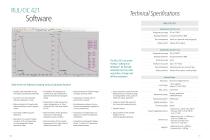
Test Atmosphere Measurements can be carried out in static air (basic version) or using an optional device for inert gas purge within the test piece area. Testing Carbon-Containing Materials For testing carbon-containing materials (e.g., magnesia-carbon graphite bricks), a non-oxidizing test atmosphere can be realized with a gas-tight test chamber (optional; see figure on previous page). This chamber can be evacuated and then purged with protective gas. Measurements can be carried out up to 1600°C. Variable Loading Device Optionally, the loading device can be equipped for load variation. The...
Open the catalog to page 6
The upper plot shows a RUL measurement (differential) on a test piece of a fireclay brick with increasing temperature. At 1387°C, the test piece reaches its maximum expansion. Deformations of 0.5% and 1.0% occurred at 1565°C (T0.5) and 1600°C (T1), respectively. Peak: 1387.0 °C Peak: 1387.0 °C Peak: 1387.0 °C 800 1000 800 1000 Temperature / °C 1000 800 Temperature / °C Temperature / °C Refractoriness under Load; test conditions: 0.2 N/mm², 5 K/min, static air The lower one shows the timescaled creep over 25 hours at a constant temperature of 1280°C. 1.0 1.0 1.0 Peak: 1283.0 °C Peak: 1283.0...
Open the catalog to page 7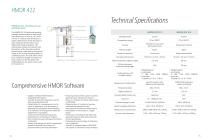
Refractoriness under Load (RUL) of Andalusite Bricks This plot shows three measurements on andalusite bricks fired at three different temperatures: 1430°C, 1470°C and 1510°C. At approx. 1425°C, all three test pieces reach their maximum expansion. After applying sample or calibration curve correction, the software calculates the characteristic T0.5, T1 and T2 temperatures from the RUL tests where 0.5%, 1% or 2% shrinkage is reached after the maximum expansion. The influence of the firing temperature can be clearly seen. RUL behavior of andalusite bricks (approx. 65% Al2O3) fired at three...
Open the catalog to page 8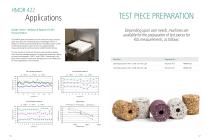
Creep in Compression (CIC) of Andalusite Bricks Test pieces of the andalusite bricks fired at different temperatures are used for CIC tests. In these tests, the load is applied once the temperature is reached (here, at 1425°C). This is contrary to RUL tests, where the load is applied from the very beginning of the measurement. This plot only shows the time-scaled creep at constant temperature (the heating segment is not depicted). 1430 0.1 CIC behavior of andalusite bricks (approx. 65% Al2O3) fired at three different 1470 temperatures; test conditions: 0.2 N/mm2, 5 K/min, static air, 25 h...
Open the catalog to page 9
State-of-the-Art Software Including Various Evaluation Routines ■ Graphic and tabulated results, calculated according to ISO/DIN ■ Correction of the measured data by calibration curves ■ Determination of characteristic data according to user's requirements ■ Automatic softening point detection ■ Derivation of curves for determination of the temperature-or time-dependent linear expansion rates ■ Possibilities for temperature control (max. 96 isothermal or dynamic temperature program steps) ■ Presentation of the measuring values temperature- or time-scaled for RUL and time-scaled for CIC ■...
Open the catalog to page 10
Model RUL/CIC 421 E/6 Temperature range RT to 1700°C Heating elements 4 Super-Kanthal 1800 Test atmosphere Static air; optional inert purge gas Safety switch Failure of test piece Model RUL/CIC 421 G/6 Temperature range RT to 1600°C Heating elements 4 Super-Kanthal 1800 The RUL/CIC runs under Proteus® software on Windows® for the fully automatic test run, data acquisition, storage and off-line evaluation. Ability to evacuate Up to 10-2 mbar Test atmosphere Static/dynamic air and inert gas Safety switches Failure of test piece, cooling water General Data Test piece 0 50 mm, height 50 mm Load...
Open the catalog to page 11All NETZSCH Analyzing & Testing catalogs and technical brochures
-
TG 309 Libra Series
24 Pages
-
STA 449 F5 Jupiter®
16 Pages
-
DMA 303 Eplexor
24 Pages
-
ARC® 244 ARC® 254
1 Pages
-
HMOR 422
1 Pages
-
RUL/CIC 421
1 Pages
-
Product Overview
12 Pages
-
Kinexus Prime DSR Series
20 Pages
-
DIL 402 Expedis Select/Supreme
28 Pages
-
Rosand Series
20 Pages
-
Kinexus Prime Series
20 Pages
-
Advanced Materials Testing
32 Pages
-
NTA Fire Testing Systems
20 Pages
-
NTA Guarded Hot Plate Series
16 Pages
-
Cone Calorimeter TCC 918
12 Pages
-
Photo-DSC 204 F1 Phoenix®
8 Pages
-
TMA 402 F1/F3 Hyperion®
16 Pages
-
NTA HotBoxes Test Chambers
16 Pages
-
Thermal Insulation Materials
24 Pages
-
TA-QMS Coupling
16 Pages
-
STA 2500 Regulus
12 Pages
-
SBA 458 Nemesis®
24 Pages
-
NTA HotBoxes
16 Pages
-
NETZSCH NEVIO Instrument Series
24 Pages
-
LFA 467 HyperFlash® Series
28 Pages
-
LFA 427 - product brochure
24 Pages
-
Kinetics NEO
16 Pages
-
TG-FTIR - product brochure
24 Pages
-
DMA GABO EPLEXOR up to 1500°C
12 Pages
-
DMA GABO DiPLEXOR
8 Pages
-
DIL 402 Expedis Classic
16 Pages
-
DEA 288 Ionic
20 Pages
-
Accelerating Rate Calorimetry
20 Pages
-
GABO DiPLEXOR®
8 Pages
-
GABOMETER®
8 Pages










